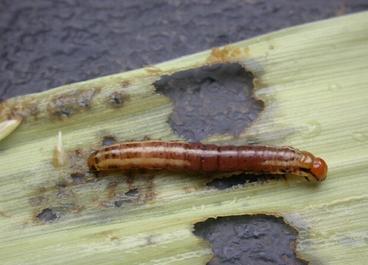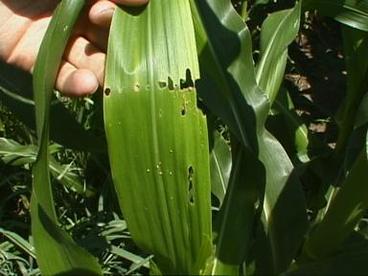E.C. Burkness and W.D. Hutchison
Department of Entomology, University of Minnesota
Introduction

The common stalk borer, Papaipema nebris, is a common pest of corn in North America, particularly east of the Rockies. Hosts of the common stalk borer include such crops as corn, fruits, other vegetables, and flowers. The larvae feed on leaves or burrow into the stem of the plant making the plant appear wilted or deformed with visible holes on the leaves and stems.
Biology & Life Cycle
The ¾ to 2 inch long common stalk borer larvae are relatively easy to identify because of their distinct coloration. They usually have a brownish to purple color with white lines running longitudinally down the body. There is an obvious saddle in the lines one fourth of the way down from the head creating an area that is a solid brown or purple color. This break takes up roughly one fourth of the entire body. As the larvae mature however, the distinguishing white lines disappear, and the majority of body color turns to a brownish-gray. At this later stage they can be confused with both the cutworm and European corn borer larvae.
The adult common stalk borer is a grayish moth with a wingspan of 1 to 1¼ inch. The front wings are a darker gray color with white or silver spots aligned in two rows. The hind wings are a lighter gray color. The adult moths typically fly at night and are not attracted to light. The adult female is capable of laying up to 2000 eggs per season. The whitish eggs are laid individually or in groups during late summer or early fall in grasses or rolled up plant leaves. Eggs will then overwinter and hatch in late April or early May. It can take a period of four to five weeks for all eggs to hatch.
After hatching, the larvae will immediately burrow into the closest stem. This will most likely be a grass or weed stem since these are preferred sites for adults to lay their eggs. By June, the larvae become too large for their initial location and will be forced to move into nearby crops that can provide better protection. In late July or early August the larvae are reaching maturity having gone through 7-10 instars.
After maturing, the larvae create cells in the topsoil where they will pupate (some larvae may pupate inside of the stem). The pupae are brown and take 2-6 weeks to develop into adults. In late August, early September, or even into October, the adults will emerge, mate, and lay eggs. Adults will not overwinter, and there is only one generation per year.
Damage
The hosts of the common stalk borer include: giant ragweed, grasses, vegetables, fruits, flowers, and more. The general rule is as long as the stem of the plant is large enough to give shelter and soft enough for the larvae to burrow into then it is a possible host.
Most of the damage caused by common stalk borer occurs in June and July when the larvae begin to move into crops. In corn, they should not be confused with the European corn borer, which infests crops later towards the end of July and into August. The first few rows of a crop, especially if next to grasses or ragweed, are more susceptible to damage then the rest of the field; however, larvae will move into the entire field when conditions are favorable or if infestation levels are high and were present the previous year.

In corn, larvae usually initiate feeding either at the base of the plant or in the whorl. If feeding begins at the base, the larvae will gradually move up the stem. Frass and castings can be seen protruding out of holes located at the base, and the associated damage will be a dead or wilted whorl while the rest of the leaves remain green. This damage is referred to as "dead heart." By contrast, if they begin to feed at the whorl and move down, the resulting damage will cause the entire plant to wilt.
In addition to the above damage, there are other visual signs to look for. For one, holes arranged in rows may appear on expanding leaves with frass present. If damage is restricted to just the leaves though, it will not be substantial enough to cause serious damage. European corn borer inflicts similar damage, yet holes produced by common stalk borer appear more ragged in comparison. Plants can appear to be stunted, deformed, twisted, or bent over, and may produce smaller than normal ears or no ears at all. Death of the plant is also possible if damage is severe.
Management
To calculate whether the use of a treatment would be profitable, an average percent of affected plants needs to be determined. One recommendation is to check 100 plants in 3-5 random locations. In general, sampling should be conducted near the edge of the field, unless the field was previously infested, or if it was previously planted with a member of the grass family. Look for feeding damage or live larvae, and write down the number of infested plants. Next, calculate the total percent infested. Action thresholds are exceeded when 3% of the plants are infested. When older larvae infest crops, the less time they have to inflict damage. Additionally, the older the plant gets, the more feeding damage it is able to tolerate. Also, take into consideration the probable yield, crop value, and the cost of applying the treatment to see if an application would be profitable.
As an example, if the larvae are in an early stage and the plants are still young and action threshold is reached, then a treatment is recommended. By contrast, if the plants and larvae are mature, then a treatment application is debatable.
Chemical control
If an infestation is observed after sampling, it is most effective to apply insecticides as soon as possible. To increase the larvae's exposure time to the insecticide, use a burn down herbicide on, mow, or burn down grasses or weeds next to the crop after the application of the insecticide. This will force the surviving larvae into the field while the spray is still on the crop.
If the infestation is isolated to the edge of the field, a border treatment is effective. Foliar insecticides are also useful.
If the field has an infestation history, it may be beneficial to apply an insecticide during the time common stalk borer larvae are hatching. Whether or not this would be profitable, however, cannot be determined since the presence or absence of the insect is not detectable at this stage. Please refer to the most recent edition of the Midwest Vegetable Production Guide.
Cultural Control
Controlling weeds and grasses in and around the field is the most useful preventative measure available. Precise timing is necessary though since burning or mowing these areas at the wrong time could actually increase the movement of larvae into the field. There are two important times when this method is most effective. First, mow or burn surrounding grasses and weeds in mid August. This will reduce locations for the adults to lay eggs, which overwinter. Another good time to burn down or mow weeds is during the early spring just before eggs hatch. It is important to make sure that eggs have not hatched though because mowing or burning will force the surviving larvae out of the weeds and into the neighboring crops.
Having an early planting date can also help lessen the severity of the damage. Larger plants are less susceptible to injury, so the longer a plant has to mature before larvae move into the field the better.
Organic control
Single plants affected can be carefully split open and the larvae removed. The stem then needs to be banded back together. Another organic option is to stick a needle in at regular intervals along the stem. The needle will hopefully hit and kill the larvae inside.
Biological Control
Birds and small mammals are among the natural predators of the common stalk borer. Naturally occurring beneficial insects include a Tachinid, Gymno chaeta ryficornis, Braconids, Apanteus papaipemae and Meteorus leviventris, an Inchneumoid, Lissonota brumnea and a Eulophid, Sympiesis viridula.
References
Bessin, R. The Common Stalk Borer in Corn. 1995. https://entomology.ca.uky.edu/ef100
Cornell University. 2003. Vegetable Disease ID and Management http://vegetablemdonline.ppath.cornell.edu/
Metcalf, R.L. & R.A. Metcalf. 1993. Destructive and Useful Insects. 5th Edition. McGraw-Hill, Inc. New York.
Nielsen, G.R. 1997. Stalk Borer.
Willson, H.R. & B. Eisley. Insect Pest of Field Crops; Bulletin 545.
Wright, R.J., T. Hunt, K. Jarvi. 2000. Common Stalk Borer in Corn. http://www.ianrpubs.unl.edu/pages/publicationD.jsp?publicationId=515